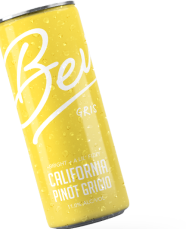
pinot grigio
how is it made?We may have mentioned that Pinot Grigio wines come from a varietal mutation of the red wine Pinot Noir grape. Although this variety is considered distinctly Italian, the grape in fact hails from France where it’s called Pinot Gris -- the gris meaning grey in reference to those recognizable blue-gray grapes. Even though Pinot Grigio is a white wine it’s made with a red grape, not a white grape. It’s only made white by discarding the thin skins and pressing just the juice inside. Thus that pale golden color Pinot Grigio is known for is left behind -- no stems or skins here! Northern Italy still dominates the global production of this grape. Though it’s synonymous with Italy, Pinot Grigio is a global grape grown across a variety of wine regions and places including Oregon, New Zealand, and Australia. With over 60,000 hectares of Pinot Grigio planted all over the world. Pinot Grigio grapes tend to do best in relatively cool climates and the flavors vary widely depending on where the grapes are grown.
what does it taste like?Pinot Grigio wines are usually medium to light bodied, dry, and acidic. Like we mentioned before, this truly depends on the growing region, as some even end up producing a semi sweet wine instead of the standard dry white wine. They are typically smooth and silky in texture and can range from very pale yellow to a deep gold color. Some of the most common flavors include fruit flavors like lemon, green apple, citrus, stone fruit, honey, almond, as well as some spices. Pinot Grigios coming from warmer climates like Italy or Chile offer a style that’s more fruit forward, complex, and occasionally rich. The style of Pinot Gris produced in Alsace, France is a result of an interesting and historical tradition. For centuries, winemakers in that region were trying to reproduce a Hungarian sweet white wine and Pinot Gris was the happy accident. That’s why Pinot Gris from France can be slightly sweeter or fruity.
common pairings
Pinot Grigio’s crispness, acidity, and citrus notes leads it to be perfectly paired with light summery food. Think seafood, pasta, and chicken dishes. This white wine can be lovely with semi-soft to firm cow and sheep cheese like brie, gruyere, and mozzarella. If you are thinking of creating a beautiful snack spread start with vegetable crudite, hummus plates, or fresh fruit. All of these dishes will prove to be delicious sidekicks to a glass of Pinot Grigio.
chardonnay
how is it made?Chardonnay wine is so popular that it’s synonymous with white wine. The word in itself is easy to pronounce and let’s be honest most people who know nothing about wine at least have heard of a chardonnay. Originating in the Burgundy region of France, it takes its name from the small town in Maconnais. Now that it's grown almost everywhere wine is made and because we label it by the grape variety rather than place of origin, we tend to forget that certain appellations such as Montrachet and Meursault are the original locations of Chardonnay and chardonnay grapes. California had over 90,000 acres of vineyards planted with chardonnay in 2018. It’s the next common white wine grape next to French colombard. Winemakers appreciate chardonnay because it’s extremely easy to grow. Chardonnay is like the perfect first child who gets straight A’s in every class. Just like other varieties of white wine such as sauvignon blanc, chardonnay has a blank canvas aspect allowing winemakers to flex their technique and be true artists with the wine. Fermenting wine in barrels gives added tannin and structure as well as flavors of toast and spice. New barrels can impart more of these flavors to wine while older aged barrels give more texture. Most of the US has been introduced to chardonnay that was fermented completely in new barrels and we came to identify those flavors with the wine rather than the barrel. I guess what we’re trying to say is that your chardonnay should never taste like a bucket of buttered popcorn.
what does it taste like?Like all wines, Chardonnay can taste different depending on the terroir and climate. Chardonnay’s flavors go from lemon zest to minerality to baked apple and to even tropical fruits. This wide range in flavors has us confused. How does chardonnay do it? Climate and harvest date. The cooler the climate, the more citrus notes become apparent. The same applies to the grapes that are harvested early. In warmer climates and later harvests, grapes develop more sugar and lose acidity. That’s when flavors develop into more rich and riper fruits. Chardonnay can also have secondary flavors that come from the use of oak. These secondary notes can include coconut, vanilla, and baking spices. Factors that will affect these flavors include the origin of the wood (French v. American), shape of the wood (barrels or chips), and length of time left in contact with the oak.
common pairingsLike all white wines, Chardonnay should be served chilled. Ideally, the best temperature range is between 50-55F which can be achieved by two hours in the refrigerator or 30-40 minutes in an ice-water bath. Chardonnay is incredibly versatile. Crisp, pure, unoaked Chardonnay goes great an aperitif with fresh cheeses like goat cheese as well as oysters, shellfish, or fish. Work your way up to medium bodied Chardonnay pair well with firmer fish and white meats like chicken and pork tenderloin. Fat, rich, and oaky Chardonnay styles with higher alcohol content can handle creamier sauces, grilled meats, and even game birds. The key with chardonnay is to match the wine’s weight with the weight of the food.
is one better than the other?
They may look nearly identical in a wine glass but the similarities between Chardonnay and Pinot Grigio end there. Pinot Grigio is light with hints of green melon while Chardonnay is heavier and might have the scent of fresh-cut grass. Like we’ve mentioned Pinot Grigio has high acidity levels and it usually tastes less sweet than a Chardonnay, Pinot Grigio is less dry and doesn’t have the same oak flavors and aroma Chardonnay is known for. Although these wines are incredibly popular, there is only one way to find out if one is better than the other - pour yourself a glass!
Sources:
https://www.dhbusinessledger.com/business/20181009/5-things-you-may-not-know-about-pinot-grigio
https://www.winemag.com/2018/09/13/the-essential-guide-to-chardonnay/
https://www.conclusionwines.com/pinot-grigio/
SHOP BEV NOW




 MY COOLER
MY COOLER



